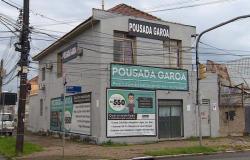A large section of the 2.4 km long bridge immediately collapsed, and eight workers who were working at the site at the time of the collision fell into the water. Two were rescued on the same day, the bodies of two others recovered on Wednesday — and the search continues for the other four, all presumed dead.
The incident closed a major US port, raising fears there could be repercussions for global supply chains.
Investigators are investigating the cause of the accident. The ship’s data recorder has been recovered and may help shed light on what went wrong.
But experts say a number of factors — from the possible use of poor-quality fuel that led to a power outage or even the bridge being designed for much smaller ships — could have contributed to the collapse.
Ship began to divert two minutes before impact
A video of the incident shows the Dali losing power moments before the collision. A power outage may have caused the ship’s crew to lose control of its direction, leaving them unable to control its trajectory.
Investigators are looking into whether the possible use of contaminated fuel may have played a role in the ship’s power outage. Impure fuel can cause problems in a vessel’s engines and power generation.
“The vessel was inoperable, with no steering power and no electronics,” an official told Fox News.
“One of the engines sputtered and then stopped. The smell of burning fuel was everywhere in the engine room, and it was pitch black.”
As soon as it ran out of power, the ship headed uncontrollably towards the bridge. The crew’s efforts to mitigate the impact, including steering sharply into port and dropping the anchor, ultimately proved futile.
“This is a really big ship. And the linear momentum and energy associated with this ship moving even just a few kilometers per hour is tremendous,” says Sanjay Raja Arwade, professor of civil engineering at the University of Massachusetts Amherst in the US. .
At a news conference on Tuesday, Transportation Secretary Pete Buttigieg said the Key Bridge, as the bridge is known, “simply was not designed to withstand a direct impact on a critical support pillar of a ship that weighs about 90.7 million kilos”.
A bridge from the last century, and a ship from this century
The Francis Scott Key Bridge was completed in 1977. At the time, the ships it was designed to pass through were much smaller than today’s giants, including the 95,000 gross ton Dali.
“The ships that crossed Baltimore Harbor back then don’t even compare,” says Norma Jean Mattei, former president of the American Society of Civil Engineers.
“The life of the project is so long—sometimes more than 100 years—that the demands on the structure can change in ways that are difficult to predict at the time of project design and construction,” explains Arwade.
He said civil engineers often think about making the structures they design redundant, meaning that one part can fail without the entire structure collapsing. But designing redundancy into piers supporting a long-span bridge would be “extremely difficult or impossible.”
He adds that other safety features, which could have helped, would have come at a cost and had limited effectiveness.
Experts said protective barriers appeared to have been installed near the bridge, but they did not prevent the ship from collapsing it.
It also appears that the bridge did not have a “bumper” — an additional layer of protection around the pillars — that could have absorbed some of the impact.
Mattei explains that mitigating risk consists of analyzing probabilities when deciding where to spend money. Ultimately, authorities may have considered that the likelihood of a huge ship hitting one of the bridge’s supporting pillars was too low to justify reinforcing them.
“We have limited dollars to invest,” she notes.
David Knight of the Institute of Civil Engineers believes that after this collapse, bridge owners around the world will evaluate how to ensure a similar catastrophe doesn’t happen again.
“Lessons will be learned, and will help us design and build even safer bridges,” he says.
Tags: Baltimore Bridge contributed collapse World
--





